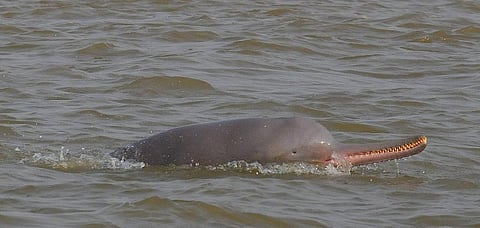

A comprehensive census conducted along nearly 1,000 kilometres of the river Ganga and its two tributaries, the Gandak and the Ghaghara, in Bihar have found about 1,150 Gangetic dolphins. Environmentalists say it is a sign of a ‘healthy river ecosystem’ as the dolphins can survive only in clean and fresh water.
“We have found about 1,150 dolphins in these rivers during our extensive survey which lasted about a month and we think the population is stable,” Zoological Survey of India (ZSI) Deputy Director Gopal Sharma told Down to Earth on Tuesday.
Shamra added that the survey was conducted simultaneously in all three rivers using direct counting method, under which, aquatic animals are counted based on their size and height when they come to the surface to breathe.
Bihar has presented a positive picture at a time at a time when dolphins are among the most endangered species on Earth and their declining numbers have been a matter of grave concern for environmentalists.
The state government-funded census was conducted by ZSI, Wildlife Trust of India (WTI) and Tilka Manjhi University, Bhagalapur between November 18 and December 10, 2018.
During the extensive survey lasting for 23 days, a huge number of 700 dolphins were traced in the 300-km stretch of the Ganga from Mokama to Manihari, 300 dolphins in another 300 stretch of the Ganga from Buxar to Mokama, a 100 animals in the Gandak river and 50 in the Ghaghara river, authorities informed. They also said they could not confirm whether the dolphins’ numbers had increased or decreased since this was the first time such an extensive survey had been conducted.
"We used the visual survey method through boats,” coordinator of Vikramshila Biodiversity Research and Education Centre, Bhagalpur, Sunil Kumar Choudhary told Down to Earth. Choudhary headed one of the three teams of experts which conducted the survey in the 300 km stretch of the Ganga from Mokama to Mahihari, which reported the highest number of dolphins.
Choudhary said the census was conducted primarily with three objectives — finding out dolphins’ population, estimating state’s marine biodiversity and finding out which part of the rivers’ habitat was rich in biodiversity.
“I am happy to inform that the river Ganga is alive in this part of Bihar. The river water quality here is relatively better than upper stream though pollution danger persists,” Choudhary asserts. “The presence of dolphins in good numbers says it all,” he added.
According to Choudhary, their teams also found out 45 bird species, some of them endangered and migratory, apart from various species of fish. “We also found out signs of presence of smooth coated otters but didn’t come across gharials,” he added.
Authorities said the continuing awareness campaign to save dolphins had worked wonders. “In Bihar, the awareness, of late, has been high and hence poaching of the mammal has declined,” Sharma said in a media report.
The campaign to save the freshwater mammal took a sudden leap after the Centre declared the Gangetic dolphin as India’s “national aquatic animal” in 2009. This happened while the Manmohan Singh-led government was at the Centre. The government had acted on the proposal moved by Bihar chief minister Nitish Kumar.
Bihar boasts of having the largest number of Gangetic dolphins, locally known as ‘Sos’. Earlier in 2012, the state tourism department even launched a dolphin watching tour of the Ganga. Officials said there are only 3,700 freshwater or river dolphins in the world. Of them, 3,200 are found in India and Bihar boasts of having the highest number of them.
Gangetic dolphins live in a zone where there is little or no current, helping them save energy. If they sense danger, they can dive into deep waters. The dolphins swim from the no-current zone to the river edge to hunt for fish and return.